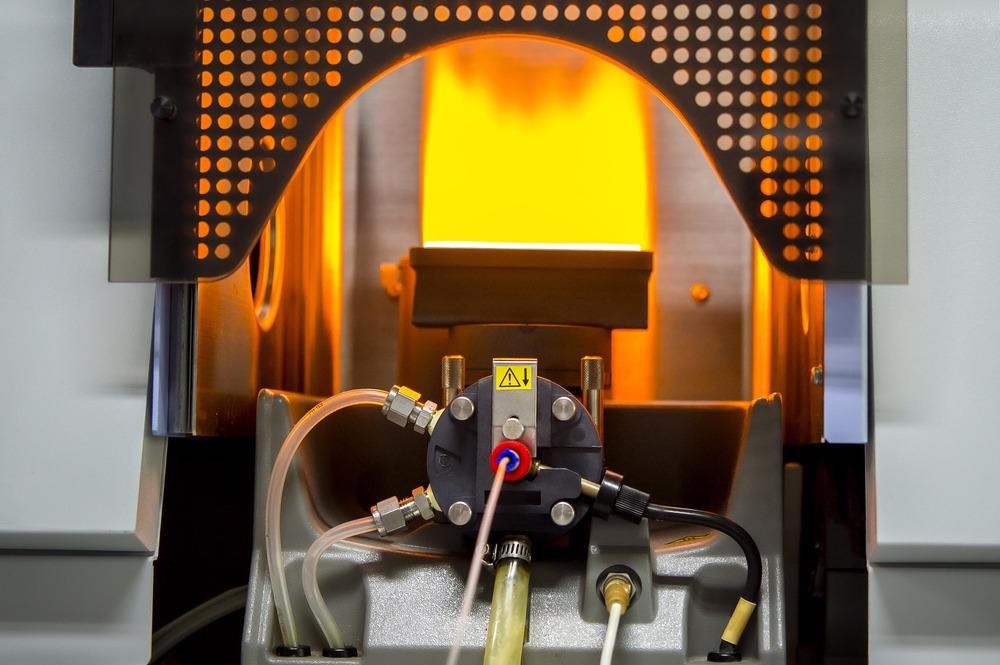Flame Atomic Absorption Spectroscopy (FAAS) is a very popular analytical technique that has been employed by researchers for the elemental analysis of trace metals in a variety of samples. How does it work, what are its applications, and what limitations are yet to be overcome?

Image Credit: Rabbitmindphoto/Shutterstock.com
While this technique has a rich history that dates back to the first half of the 19th century, modern applications and insights were largely developed in 1950 by the Australian Chemist, Sir Alan Walsh. Since then, FAAS has proven to be a very powerful tool in the qualitative determination of trace metals, independent of their form in the sample.
FAAS is a very sensitive technique and it can be used to detect the concentration of different metals up to 1ppm or even lower. In addition to its high sensitivity, this determination can be made in the presence of other elements. This means that FAAS can be employed to determine metal concentrations even in the presence of other metals—as many as 70. While this is an advantage, it does not allow for simultaneous determination of these metals, which has been one of the major setbacks of this technique since its inception.
For every test, a different light source (hollow-cathode lamp) is used. Likewise, a metal-specific wavelength is required for the detection and quantification of each metal being analyzed. Certainly, this is a major challenge in the application of FAAS in the elemental analysis of trace metals in samples. Where there are many metals of interest, the procedure becomes tedious and no longer cost-effective.
Meanwhile, many researchers have worked hard to improve the limitations and challenges of using this technique. Recent developments include the use of the much more expensive duo of Inductively Coupled Plasma-Atomic Emission Spectroscopy (ICP-AES) and Inductively Coupled Plasma-Mass Spectroscopy (ICP-MS) for the simultaneous determination of multiple metals in samples. In addition, these recent techniques offer higher sensitivity and can distinguish among oxidation states of the metal and is highly insensitive to nonmetals.
These advancements no doubt have their many benefits. However, the place of the more affordable and highly reliable FAAS cannot be disputed.
How it Works
In a typical FAAS instrument, the sample is atomized, thereby transiting from a ground state to higher energy levels. In the excited state, every element possesses a unique spectrum that distinguishes it from other elements. The spectra lines are very sharp such that there is rarely overlap, and FAAS takes advantage of this phenomenon to identify and quantify these elements.
At high temperatures, the flame atomizes the samples and the concentrations of the elements of interest are determined by using a spectrophotometer as a detector to measure the absorbance of the samples at their characteristic wavelengths.
Applications
The application of FAAS in the analysis of trace metals in different samples has been widely researched and documented. As already mentioned, this technique has its limitations in terms of its sensitivity, simultaneous determination of multiple analytes and many others. However, it is no doubt a cost-effective, less complicated and popular choice of elemental analysis. It finds useful applications in pharmaceutical analysis, water analysis, clinical research, mining, and food and beverage analysis.
In a study reported by Mao X., et al (2016), FAAS was used in the determination of manganese, zinc, iron, calcium and magnesium in extracts from the medicinal plant, Chanca Piedra. The team used a fully automated flame atomized PG-990 AAS, and the results show one of the many applications of AAS in pharmaceutical and clinical research studies.
Ramesh and his colleagues (Ramesh et al, 2001) also reported the use of FAAS in the determination of gold in organic mediums. The gold samples were present on sedimentary rocks that contained fine stones, serpentine and pyrites, and the determination was conducted successfully in the presence of these organic mediums to meet the international standards for gold.
Conclusion
FAAS is one of the most widely used AAS techniques for the quantitative and qualitative analysis of trace metals in different samples. The ability to use this technique to solve a wide range of analytical challenges that cut across different areas of medicine, environmental and scientific research is endless. However, the technique has its limitations.
Its inability to determine metals in multiple oxidation states has been reported. Likewise, other limitations including the inability to detect multiple metals simultaneously, the use of specific light sources and wavelengths for analysis and detection, etc. have been established and discussed. Recent advances have resulted in several modifications to curb these limitations, and new AAS techniques like ICP-AES and ICP-MS have been used in place of FAAS to correct these challenges. While this is a welcome development, the cost is a major challenge for these new approaches, making FAAS still one of the most frequently used options to date.
More from AZoM: Applications of Synchrotron-Based X-Ray Fluorescence Microscopy
References and Further Reading
Janusa, M. A., & Beck, J. N. (2002). Recent Applications Of Flame Atomic Absorption Spectrometry To Environmental Measurements. Applied Spectroscopy Reviews, 37(2), 137 186. https://www.tandfonline.com/doi/abs/10.1081/ASR-120006043
Ferreira, S. L. C., Bezerra, M. A., Santos, A. S., dos Santos, W. N. L., Novaes, C. G., de Oliveira, O. M. C., … Garcia, R. L. (2018). Atomic absorption spectrometry – A multi-element technique. TrAC Trends in Analytical Chemistry, 100, 1–6. https://www.sciencedirect.com/science/article/pii/S0165993617304235
Mao X, et al. (2016). The Genus Phyllanthus: An Ethnopharmacological, Phytochemical, and Pharmacological Review. Evidence-Based Complementary and Alternative Medicine, vol.2016. https://doi.org/10.1155/2016/7584952
Ramesh, S.L., Sunder Raju, P.V., Anjaiah, K.V., Ramavathi, M., Gnaneswara, R., Dasaram, B., Nirmal Charan, S., Suba Rao, D.V., Sarma, D.S., Ram Mohan, M. and Balaram, V. (2001). Determination of Gold in Rocks, Ores, and Other Geological Materials by Atomic Absorption Techniques. Atomic Spectroscopy. 22; 263-269. https://www.semanticscholar.org/paper/Determination-of-gold-in-rocks%2C-ores%2C-and-other-by-Ramesh-Raju/1a2033320e9cf9163c42ee2204073fcd84ebf6d8
Disclaimer: The views expressed here are those of the author expressed in their private capacity and do not necessarily represent the views of AZoM.com Limited T/A AZoNetwork the owner and operator of this website. This disclaimer forms part of the Terms and conditions of use of this website.